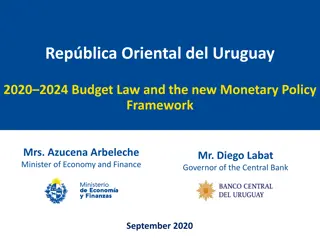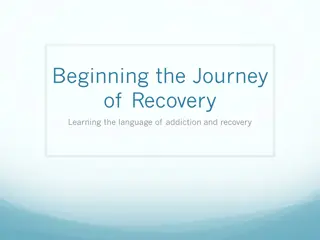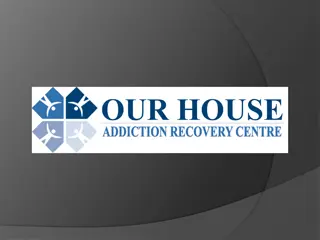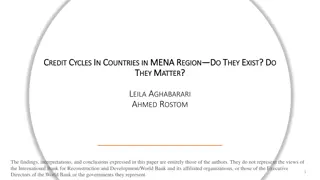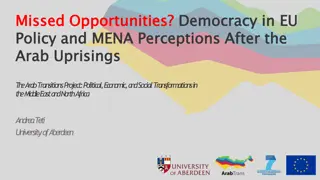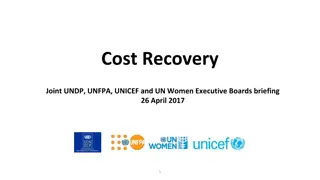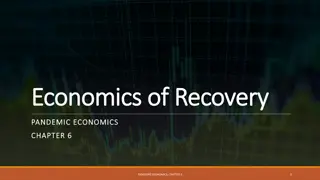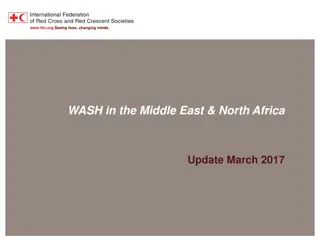Economic Update: Recovery Path for MENA Countries
The MENA region is facing a debt crisis, needing a delicate balance between short-term needs and long-term debt risks. Key findings emphasize the importance of transparency and tough decisions in public expenditure to navigate towards recovery. Despite forecasts of GDP losses and lower per capita levels, the region can chart a path for lasting recovery with strategic institutional actions.
Download Presentation

Please find below an Image/Link to download the presentation.
The content on the website is provided AS IS for your information and personal use only. It may not be sold, licensed, or shared on other websites without obtaining consent from the author.If you encounter any issues during the download, it is possible that the publisher has removed the file from their server.
You are allowed to download the files provided on this website for personal or commercial use, subject to the condition that they are used lawfully. All files are the property of their respective owners.
The content on the website is provided AS IS for your information and personal use only. It may not be sold, licensed, or shared on other websites without obtaining consent from the author.
E N D
Presentation Transcript
MENA ECONOMIC UPDATE - APRIL 2021 LIVING WITH DEBT: HOW INSTITUTIONS CAN CHART A PATH TO RECOVERY IN THE MIDDLE EAST AND NORTH AFRICA
Authors Authors DANIEL LEDERMAN Deputy Chief Economist, Middle East And North Africa, The World Bank ROBERTA GATTI Chief Economist, Middle East and North Africa, The World Bank HA MINH NGUYEN Senior Economist, Office of the Chief Economist, Middle East and North Africa, The World Bank ASIF ISLAM Senior Economist, Office of the Chief Economist, Middle East and North Africa, The World Bank RACHEL YUTING FAN Economist, Office of the Chief Economist, Middle East and North Africa, The World Bank CLAUDIO ROJAS Consultant, Office of the Chief Economist, Middle East and North Africa, The World Bank SULTAN ALTURKI Consultant, Office of the Chief Economist, Middle East and North Africa, The World Bank
The Middle East and North Africa (MENA) region is still in crisis MENA countries face a balancing act between short-term needs and long-run risks of public debt Main Findings Tough choices: public expenditure priorities depend on the phase of the recovery Sunlight can help! Transparency can help chart a path to lasting recovery for MENA
A Region Still In Crisis: Long-Lasting Losses in GDP GDP level- MENA GDP per capita level - MENA 1.10 1.10 1.05 1.05 7.2% 1.00 1.00 7.0% 0.95 0.95 0.90 0.90 2019 2020 2021 2019 2020 2021 MENA (Pandemic) MENA (No Pandemic) MENA(Pandemic) MENA(No Pandemic) By 2021, the regional economy is forecast to be 7.2 percentage points below the no-pandemic GDP level, equivalent to 227 billion dollars; GDP per capita (an indicator of the level of development that determines poverty) will still be lower than the 2019 level by approximately 5%
A Region Still in Crisis: GDP per capita Losses Losses by 2021: Panel A: MENA Panel B: MENA Country Groups 1.10 1.10 MENA: 7.0% 1.05 1.05 GCC: 7.3% Middle-income oil exporters: 4.6% 1.00 1.00 Middle-income oil importers: 8.6% 0.95 0.95 0.90 0.90 2019 GCC (Pandemic) GCC(No Pandemic) Developing Oil Exporters(Pandemic) Developing Oil Exporters(No Pandemic) Developing Oil Importers(Pandemic) Developing Oil Importers(No Pandemic) 2020 2021 2019 2020 2021 MENA(Pandemic) MENA(No Pandemic) Source: World Bank, Macro and Poverty Outlook(in April 2021 and October 2019) and World Bank staff s calculation. Note: The dotted lines show forecast GDP per capita levels in the counter-factual case of no pandemic (based on GDP per capita forecasts in October 2019). The straight lines show forecast GDP per capita levels in the case of pandemic (based on GDP per capita forecasts in April 2021).
A Region Still In Crisis: Conservative Estimates Of Millions of New Poor Projected Poverty (below $5.5/day) 200 195 Number of poor people 190 192.0 (millions) 14.2 million 185 180 177.8 175 170 2019 2020 2021 Without Covid Crisis Apr-21
A Region Still In Crisis: Regressive Food-Price Inflation Feb 2020 Feb 2020- -March 2021 March 2021
Walking the Tightrope of Rising Public Debt 90 MENA World 80 Balancing act is most difficult among MENA s Middle-Income Oil- Importing economies. 70 percent of GDP 60 50 40 30 High income Middle-income Middle-income oil importers High income Middle-income Middle-income oil importers oil exporters oil exporters 2019 2020 Source: World Bank, Macro and Poverty Outlook(April 2021) Note: Country groups are represented by median observation of the group. The bars show median debt of MENA country groups. The diamonds show median debt of the corresponding world s income groups. Debt data are generally not available for MENA low income (Yemen and Syria). The high-income group in MPO is limited to only countries covered by the World Bank.
A Region Still In Crisis: Quantifies the socio-economic pain Walking the Debt Tightrope: Articulates the tensions between immediate socio-economic needs and long- run risks in a region that already had high levels of debt in 2019 This Report Tough Choices ahead: Discusses priorities during the pandemic, after the pandemic, and beyond Sunlight Can Help: Highlights the role of institutions, especially transparency, in charting a path to recovery for the Middle East and North Africa
Walking the Debt Tightrope: Tension between Short-term Needs and Long-term Costs of Public Debt Long Term Risks Crowding out of private investment (as interest rate rises) Crowding out of public investment as interest payments rise Macroeconomic vulnerability, rollover risk, and likelihood of costly debt crises Short Term Needs Disaster Relief: Supporting firms and households Public Health Spending
Walking The Debt Tightrope Short-term Needs of Public Debt: Lessons From Disaster Relief 4 4 Historical Evidence: 3 3 During and immediately after disasters, debt grows faster (>2%) in disaster economies than in control group (economies-years with no disasters) Public debt growth, annual % GDP growth, annual % 2 2 1 1 0 0 Growth plummets during disaster but recovers in the aftermath relative to control group. -3 -2 -1 t=0 1 2 3 -1 -1 -2 -2 Timeline around a large natural disaster, years Public debt growth, annual % GDP growth, annual % (RHS)
Walking the Debt Tightrope: Long-term Risks of Public Debt Association between High Public Debt and Low Growth during 2000-2019 Median Annual per Capita Growth During 2000-2019 across Countries Ranked by Central Government Debt in 2000
Priorities during the Pandemic: Public Spending for Disaster Relief and Public Health During the pandemic: disaster relief, support households and firms Aggregate demand stimulation might have little effect on GDP (the "fiscal multiplier") if the risk of Covid-19 remains Investment in public health to save lives and generate long-term gains Disease surveillance and data transparency Testing and contact tracing Vaccination campaigns Partial Correlation between Test Positivity Rates and GDP Downgrade Sources: IMF, World Economic Outlook; Worldometer; Johns Hopkins University; World Bank, World Development Indicators; and World Bank staff calculations. Note: The figure shows the partial correlation between 2020 growth adjustments between October 2020 and October 2019 and Covid-19 positivity rate (as of December 2020). The positivity rate is the number of Covid-19 cases as a percent of the total number of tests. Other explanatory variables include log of GDP per capita in 2019 (in U.S. dollars), total trade value in GDP in 2019 (percent), days since the first positive case until November 30, 2020, and tourism as a percent of exports in 2018. Also can reduce economic costs of the pandemic
Priorities as the Pandemic Subsides Factors that reduce the need and efficacy of traditional fiscal stimulus Potential benefits of (targeted) stimulus healing economic scars 1. Pent-up demand can raise GDP without fiscal stimulus If consumers (e.g., foreign tourists) believe that the pandemic is over High debt has been associated with low fiscal multipliers (Huidrom et al., 2020) Fiscal multiplier of public investment is low when governance is poor (Izquierdo et al., 2019) 1. Financial constraints prevent enterprise re-entry 2. Scarring of idled workers, particularly the young entering the labor force 3. Support schools to recover lost human capital 2. 3.
Mitigating the Costs of Public Debt after the Pandemic Refinance maturing debt on more favorable terms by enhancing debt reporting transparency Improving institutions: Indebted countries are more likely to enter costly debt-distressed periods when they experience low growth and weak governance.
Good Governance Can Help: Evidence from Episodes of Debt Distress Panel A: Difference in GDP Growth (percentage) Panel B: Difference in Governance (score) 0 0 -0.1 -1 -0.2 -2 -0.3 -3 -0.4 -4 -0.5 -5 Countries that defaulted minus the control group Countries that preemptively restructured minus the countrol group MENA middle income minus the control group MENA middle- income oil importers minus the control group Lebanon minus the control group Countries that defaulted minus the control group Countries that preemptively restructured minus the countrol group MENA middle income minus the control group MENA middle- income oil importers minus the control group Lebanon minus the control group Note: Control group = developing countriess with no debt distress (debt restructuring) episodes
Reduce costs, accelerate recovery During the pandemic Public health surveillance and transparency can reduce costs of the pandemic. Charting a Path to a Lasting Recovery: Raise investment s impact As the pandemic subsides Transparency in public investment decisions can raise its impact on economic activity (GDP) Public health surveillance and transparency can accelerate the post-pandemic rebound (e.g., tourism; hospitality industries). Sunlight Can Help! Reduce costs, reduce risk After the pandemic Transparency can reduce borrowing costs. Good governance can reduce the risks of debt distress.
THANK YOU! THANK YOU!
Appendix Table B1: World Banks Growth, Current Account and Fiscal Account Forecasts
Appendix Table B2 Panel B (Between April 2021 and October 2020):








